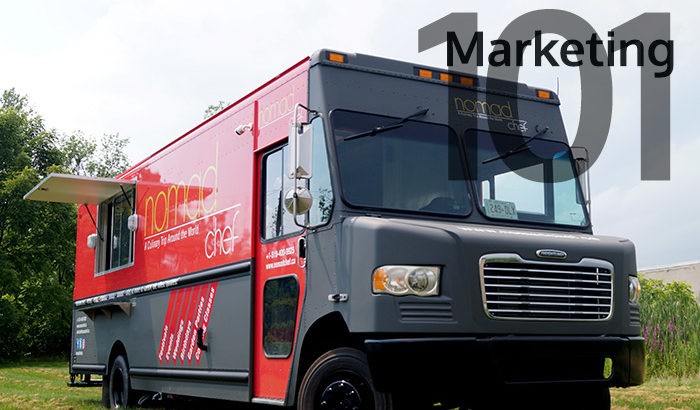Food Truck Marketing 101: How to Find and Attract Customers

Whether you have recently started your business, or have been running it for a while, food truck marketing may well be the most important aspect of your business. It does not matter how good of a product you offer if you have no customers to sell it to. At its very core marketing is about conveying the value of your product to your (potential) customers. In a traditional marketing approach, marketing is composed of four aspects. To successfully market your business, you must consider the product, the price, the “place”, and the promotion. A great food truck marketing plan will take these four elements, allowing them to work together seamlessly.
FOOD TRUCK MARKETING 101: HOW TO ATTRACT CUSTOMERS
In order to market effectively, you need to think holistically. While the discussion below follows a linear progression from the product through to promotion, in reality, you cannot make these decisions in isolation. Your promotion will depend on your product, and your product will depend on your place. Choosing a place needs to correspond to your pricing, or perhaps pricing to correspond to place. What separates a business that is well-marketed, from one that is not, is the cohesiveness of the strategy. With that in mind, let’s get started!
THE FIRST “P”: PRODUCT
Food truck marketing starts with the product. What is it that you are providing to your customer? If you are an established food business, you may have a good idea on the items that you will be selling to customers. If you are starting out you must begin by determining what is on your menu. This process should be customer-focused. What is it that your (potential) customers want? This is much easier than determining your menu and attempting to find customers that will enjoy that food. Luckily in the restaurant market, there is often a wide range of customers. You will always have customers that will be enticed to what you are providing.
It is important to never think of your menu as fixed. Test out which items people like the best, and listen to criticism on what can be improved. At the end of the day, the customer is your boss; your job is to keep them happy! They can help you a lot in this process.
THE SECOND “P”: PRICE
With your menu in hand, food truck marketing turns to focus on the price. Many decisions that customers make are price-driven. The price must be right for them and you. In general, you are looking to find a price that maximizes profit – not volume. In some cases, however, setting the price too low will create a sense of inferior quality.
SOME PRACTICAL GUIDANCE ON PRICING
There are some practical considerations to make in determining your pricing. The first (and a very important consideration) is the cost of producing the product. Consider the cost of everything (labor included) that goes into making the product. Also included in this is your overhead costs required to simply run the business. This acts as the very lowest price that you can charge for your products (on average). It is possible to sell some items at a loss if you are confident that you will make this up elsewhere (printers are sold cheaply, with the hope that ink sales drive profits).
THE THIRD “P”: PLACE
Next in the four “P”s, which is particularly interesting in the context of mobile food businesses, is the place. Place refers to, in part, the physical location of your business. More broadly, it is about how your product gets from you to your customers.
The location of your food truck will have a major impact on how well your business does. This starts by finding a great spot to operate your business. Likely it should have a lot of pedestrian traffic and high visibility. You can settle on a permanent location but the best part of a mobile food business is that if a spot is not working, you can move. Many popular locations for food trucks include:
- The parking lot of large retail store or mall
- Factories
- Industrial park or commercial complex
- Park, beach, pier, zoo, golf course
- Sports fields
- Downtown street corner or parking lot
- University, college, high school
- Courthouse, military base, government complex
- Office building, hospital, call center
- Transportation center (bus, train, subway, airport) Marina, truck stop
- Service station, car washes
In addition to your daily locations, you can look at temporary locations for special events. These may not be available every day but can provide you with a high volume of extra customers in short bursts. Some examples of special events include:
- Sporting events such as soccer, baseball, football
- Car shows & rallies, farm shows, boat shows, air shows, industrial or home shows
- County fairs, cultural events, carnivals, fishing derbies, auctions, parades
- Flea markets, music festivals, antique, and craft shows, tourist attractions
- Grand openings, open houses, large sales events, car dealers
- Business anniversaries, company picnics & banquets, conventions
- Charity events, church /club /school functions
- Music Festivals
- Catering parties and anniversaries
EXTENDING PLACE: THINK OF THE EXPERIENCE
In the current generation, there has been a lot of talk about “buying experiences.” Everything, from shopping for clothes to watching a movie, has to have an experience associated with it. In order to be competitive, it is no longer enough to simply sell a good product – you have to sell an experience, built on a great product. One of the ways to accomplish this is in clever execution of “place”. If you have a set location, there is still plenty to decide about how the food gets from you to your customers. The standard convention is simply to take orders at a window and through the same window hand the food back to the customer. This works, but it will not be a differentiator.
Think about every step of the process, from taking an order (maybe customers can place orders through an app?), to waiting for their order (is it possible to have seating? or perhaps entertainment while they wait?), to receive their orders. Is it possible for them to customize, and if so, is there a good process for that (Pita Pit and Mucho Burrito let you see the ingredients you are choosing! Every little detail matters, and it is worth investigating every assumption that you are making.
THE FOURTH “P”: PROMOTION
The final piece of food truck marketing comes with advertising and promotion of your business. The options are endless when it comes to advertising but we can give some great options to get you started.
First off, your mobile business is a portable billboard. Having an eye-catching design on your truck is a great way to get the customers attention. A great option is pairing with local businesses that can be complementary to your food truck. This could include sports complexes, car dealerships, or shopping centers. You can also utilize traditional advertisements with road sign billboards or even radio and TV commercials.
These methods are still good but in the age of the internet, there are many ways to reach customers at little to no cost at all. Social media is an amazing and cost-effective tool. An effective social media presence can draw in new customers and keep loyalty with your existing ones. An active presence on Facebook, Twitter, and Instagram will allow people to know where your truck is each day, what food you serve, and increase the size of your audience.
Starting a blog is also a great and inexpensive way to keep your customers engaged and post content about upcoming events, specials you are having or new things you are offering. Setting up your business with Google Places is also a very quick way that can gain a lot of customer traffic as it allows customers to find your food truck when searching restaurants in your area.
CONCLUSIONS
Food truck marketing is essential to take your business from operational to successful. Just remember that there is more to food truck marketing than advertising. It requires a focus on the product and what makes yours unique. You must consider what value your customer’s derived, and price accordingly. In addition, you must consider where and how you reach your customer. Finally, you can decide on the promotion you use to attract customers. If you keep these in mind and focus on them from the start, you will be pleased with how quickly you can find success with your mobile food business.
Feel free to contact us with your questions 1 855 405 2324 or visit our website at venturefoodtrucks.com.



